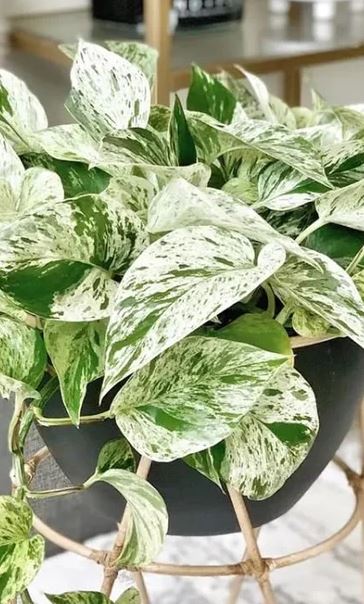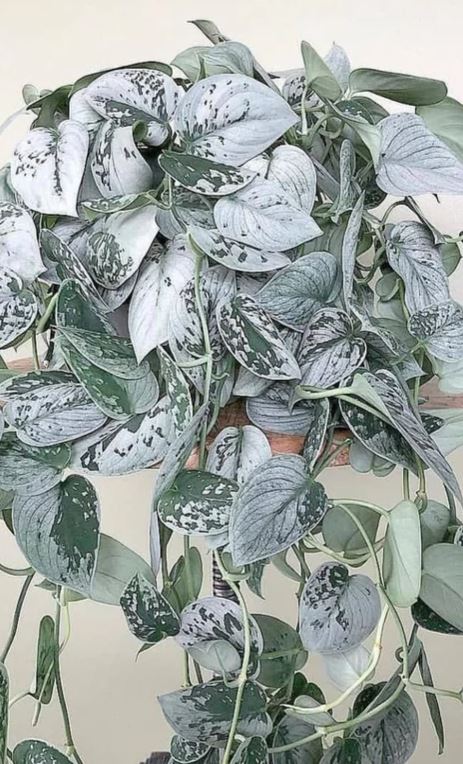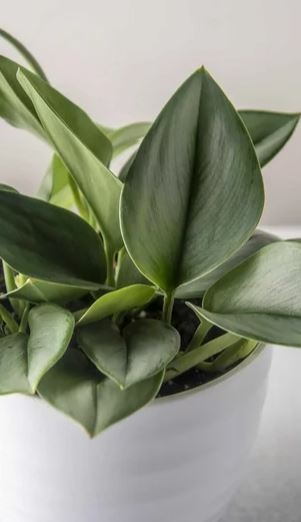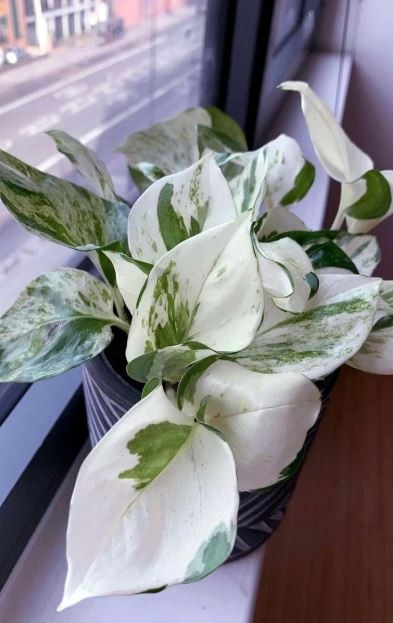Pothos Plants | Exotica | Marble Queen

Pothos Facts
Pothos (Epipremnum aureum):
- Pothos, also known as Devil’s Ivy, is a popular trailing vine plant that belongs to the Epipremnum genus.
- Pothos plants have heart-shaped leaves with a glossy texture.
- The most common variety of Pothos has green leaves, but there are variegated cultivars available, such as ‘Marble Queen’ and ‘N’Joy’.
- Pothos is known for its ability to tolerate various light conditions, including low light. It can adapt to different environments.
- This plant is relatively low-maintenance and thrives in well-draining soil. Allow the soil to partially dry out between waterings to prevent overwatering.
Introducing Our Pothos Collection
Silver Exotica (Epipremnum aureum ‘Silver Exotica’)

- Appearance: Pothos Silver Exotica has distinctively variegated leaves. The leaves are heart-shaped and feature a combination of green and silver-white markings. The silver markings can vary in intensity, with some leaves exhibiting more silver than others.
- Growth Habit: Like other Pothos varieties, Silver Exotica is a trailing vine. It typically grows long, cascading stems that can be trained to climb or hang. It is an excellent choice for hanging baskets or placed on high shelves where its trailing vines can cascade down.
- Care Requirements: Pothos Silver Exotica is relatively easy to care for, making it a popular choice among houseplant enthusiasts. It thrives in well-draining soil and prefers indirect or filtered light. It can tolerate lower light conditions, but the variegation may become less pronounced. Allow the soil to dry out partially between waterings, as overwatering can lead to root rot.
- Air-Purifying Qualities: Like other Pothos varieties, Silver Exotica is known for its air-purifying properties. It can help remove toxins such as formaldehyde, benzene, and xylene from the air, making it a great choice for improving indoor air quality.
- Propagation: Pothos Silver Exotica can be easily propagated through stem cuttings. Simply cut a section of the stem below a node (where leaves emerge) and place it in water or moist soil. Roots will develop, and a new plant will grow from the cutting.
Sterling Silver (Scindapsus pictus ‘Argyraeus’)
- Appearance: The Sterling Silver Pothos (Scindapsus pictus ‘Argyraeus’) is a striking houseplant known for its unique foliage. Its leaves are heart-shaped, with a velvety texture and a beautiful silver-gray color. The leaves have dark green veins that contrast with the silvery background, giving it an elegant appearance.
- Growth Habit: This Pothos variety has a trailing growth habit, with long vines that can cascade down from hanging baskets or climb up if provided with a support structure.
- Care Requirements: The Sterling Silver Pothos is a relatively easy-to-care-for plant. It thrives in well-draining soil and prefers bright, indirect light. However, it can tolerate lower light conditions as well. Allow the soil to dry partially between waterings, as overwatering can lead to root rot. This plant also appreciates moderate humidity levels.
- Propagation: Like other Pothos plants, the Sterling Silver Pothos can be propagated through stem cuttings. Take a cutting below a node and place it in water or moist soil until roots develop.
- Air-Purifying Qualities: Pothos plants, including the Sterling Silver Pothos, are known for their air-purifying abilities. They can help remove toxins from the air, contributing to improved indoor air quality.

Manjula (Epipremnum aureum ‘Manjula’.)

- Appearance: Manjula Pothos is a cultivar of the Epipremnum aureum plant, commonly known as Pothos or Devil’s Ivy. It features heart-shaped leaves with variegation patterns. The leaves have a mix of green, silver, and creamy-white colors, often with splashes or marbling of different shades.
- Growth Habit: Manjula Pothos is a trailing vine plant that can grow long, cascading stems. It is an ideal choice for hanging baskets, shelves, or as a climbing plant when provided with a suitable support structure.
- Care Requirements: Manjula Pothos is generally easy to care for, making it a popular houseplant. It thrives in well-draining soil and prefers bright, indirect light. However, it can tolerate lower light conditions, although the variegation may become less prominent. Allow the soil to partially dry out between waterings and avoid overwatering to prevent root rot.
- Air-Purifying Qualities: Like other Pothos varieties, Manjula Pothos is known for its air-purifying properties. It can help remove toxins from the air, improving indoor air quality.
- Propagation: Manjula Pothos can be propagated through stem cuttings. Take a cutting with a few leaves below a node (where leaves emerge) and place it in water or moist soil. Roots will develop, and a new plant will grow from the cutting.
NJOY (Epipremnum aureum ‘N’Joy’)
- Appearance: The N’Joy Pothos features heart-shaped leaves with a striking variegation pattern. The leaves are predominantly green with creamy-white or yellowish patches and marbling. The variegation can vary in intensity and pattern, creating a beautiful contrast between the colors.
- Growth Habit: Like other Pothos varieties, the N’Joy Pothos is a trailing vine. It produces long, cascading stems that can be trained to climb or left to hang. This plant looks particularly stunning in hanging baskets or when placed on high shelves.
- Care Requirements: N’Joy Pothos is known for its ease of care, making it a popular choice for beginners. It prefers well-draining soil and can tolerate a variety of light conditions. While it thrives in bright, indirect light, it can adapt to lower light levels as well. Allow the soil to dry out partially between waterings to avoid overwatering.
- Air-Purifying Qualities: Like other Pothos varieties, N’Joy Pothos is known for its air-purifying properties. It can help filter and cleanse the air by removing toxins such as formaldehyde, benzene, and xylene.
- Propagation: N’Joy Pothos can be easily propagated through stem cuttings. Take a cutting just below a node (where leaves emerge) and place it in water or moist soil. Roots will develop, and a new plant will grow from the cutting.

Marble Queen (Epipremnum aureum ‘Marble Queen’)

- Appearance: The Marble Queen Pothos is a variety of Pothos with distinctive marbled variegation on its leaves. The leaves are heart-shaped and feature a combination of green and creamy-white or yellowish variegation. The variegation patterns can vary, creating unique and beautiful designs on the foliage.
- Growth Habit: Marble Queen Pothos is a trailing vine plant that grows long, cascading stems. It can be trained to climb or left to hang, making it a popular choice for hanging baskets or as a trailing plant on shelves or walls.
- Care Requirements: Marble Queen Pothos is relatively easy to care for. It thrives in well-draining soil and can tolerate a range of light conditions. While it prefers bright, indirect light, it can adapt to lower light levels as well. Allow the soil to partially dry out between waterings to prevent overwatering and root rot.
- Air-Purifying Qualities: Like other Pothos varieties, Marble Queen Pothos is known for its air-purifying properties. It can help remove toxins from the air, improving indoor air quality.
- Propagation: Marble Queen Pothos can be propagated through stem cuttings. Take a cutting just below a node (where leaves emerge) and place it in water or moist soil. Roots will develop, and a new plant will grow from the cutting.
- Toxicity: It’s important to note that Pothos plants, including Marble Queen Pothos, are toxic to pets if ingested. Keep them out of the reach of cats, dogs, and other animals that may chew on the leaves.
Purchasing a Pothos?
Our Pothos Collection is available on our Esty shops.